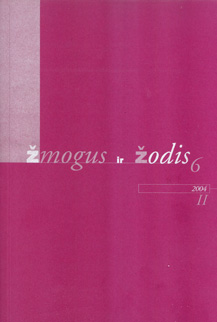Mėnulis XX amžiaus lietuvių literatūroje
The Moon in the Lithuanian Literature of the 20th Century
Author(s): Loreta MačianskaitėSubject(s): Literary Texts
Published by: Vytauto Didžiojo Universitetas
Keywords: figure; system of values; semantic; manifestation; history of the image.
Summary/Abstract: It is not the aim of this paper to discuss all representations of the Moon in Lithuanian literature. Based on the principle of figurative isotope, an attempt is made to distinguish steps in the development of the moon isotope, the unfolding of its narrative functions, and its relation to the changing rhetoric and consciousness patterns in the mosaic of different texts representing the Lithuanian discourse of the 20th century. In the domain of literary reflections, seeking proximity to the moon is a metaphoric parallel of the passion to write itself; the lunar code performs an important function in the discourse manifesting personal emotions. The moon figure is eliminated from the romantic discourse, produced by priests; in the case of neo-romantic and futuristic poetry and the moon image undergoes the transformations of “desemantisation” and “desacralisation”. The postwar Lithuanian prose produced both in exile and in Lithuania shows the growing trend to escape the reality by retreating to the the utopian realm of the “the lost paradise”. It is a prominent trend in the Lithuanian agrarian prose to attribute the role of a protector of the spiritual values of the nation that are on the brink of extermination to the moon. The relation of the dialectics of love with the change of moon phases is characteristic of womens’ poetic discourse. The exile writers should choose the dynamic metaphor of the crumbling moon in order to express the constraints of the history. Lithuanian authors reflecting the experience of the war years would opt for the images of the moon ring or a narrowing circle. The crumbling moon metaphor is more popular with the Lithuanian literature where the monolith of the faēade culture began to collapse in the reality. The moon figure in the post-modern discourse usually signifies semantic pluralism.
Journal: Žmogus ir žodis
- Issue Year: 06/2004
- Issue No: 2
- Page Range: 26-32
- Page Count: 7
- Language: Lithuanian

